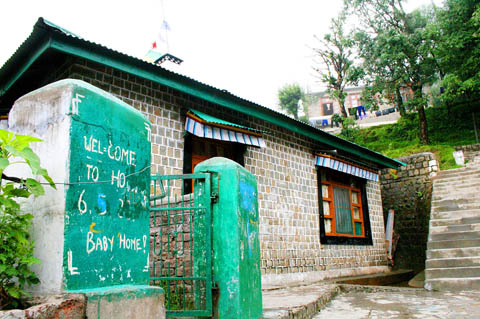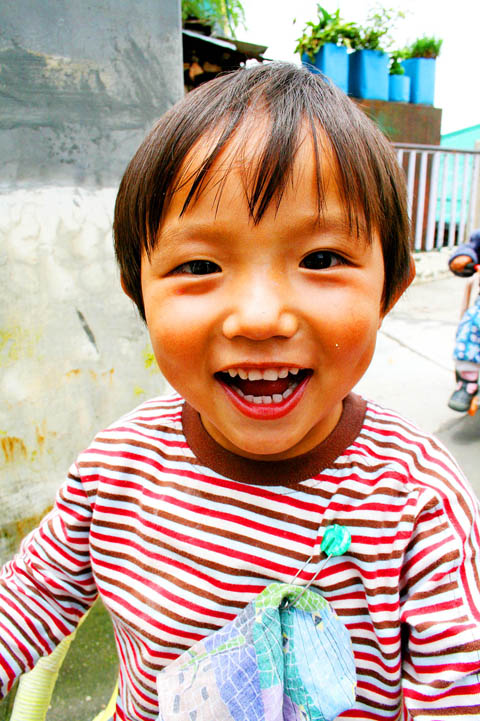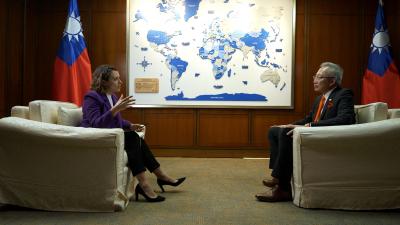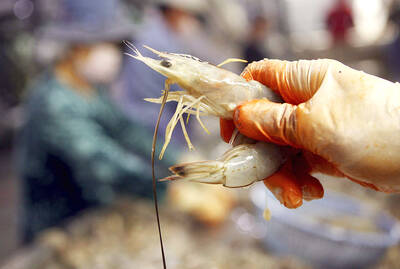Life in exile may be difficult, but love from around the world has made it a little easier for Tibetans.
For nearly half a century, foreign aid — from medical assistance to agricultural programs and shelter for children — has played an important role in Tibetans’ life in exile.
Taiwan has been just such a donor.

PHOTO: LOA IOK-SIN, TAIPEI TIMES
Walking into the Tso-Jeh Khangsar Hospital in the Tibetan settlement in Bylakuppe, India, an ambulance is parked in the courtyard with the words “Donated by the Love and Care Committee, Taiwan, through the Deparment of Health, Central Tibetan Administration” written on it.
Phakmo Tso, the only full-time doctor at the hospital, stood in the courtyard and greeted her guests — a delegation from the Taiwan-Tibet Exchange Foundation (TTEF) — giving each a white khata, a silk scarf used by Tibetans to greet or show respect to someone. The delegation then handed Tso a few boxes with small disposable medical supplies.
“We have been here several times and we always bring medical supplies when we visit,” said Own Su-jei (翁仕杰), the foundation’s deputy secretary-general.

PHOTO: LOA IOK-SIN, TAIPEI TIMES
On his most recent visit last year, Own brought something much bigger than medical supplies: He was there to inaugurate a new wing of the hospital donated by the TTEF and the International Cooperation and Development Fund, Taiwan (ICDF-Taiwan).
“Love from Taiwan: the general in-patient ward, eye operation theatre, education hall and staff quarters are donated by ICDF-Taiwan and Taiwan-Tibet Exchange Foundation,” a stone plaque embedded in the wall at the entrance of the new wing reads. “Furniture and equipment donated by Dr Raffaella France Chionna and Italian friends.”
“We’ve had medical and agricultural aid programs for [Tibetans in exile] since 2004,” Own said. “During the first two years, we provided first aid, dentistry and pediatrics training to physicians from [the southern Indian State of] Karnataka in first aid.”
Own said they had picked Karnataka because the state counts five Tibetan settlements — including Bylakuppe — with approximately 40 percent of the exiled Tibetan population.
Later, the TTEF learned from the Tibetan government in-exile that it wished to upgrade the hospital in Bylakuppe, but lacked money, Own said.
“So we asked ICDF for help and built the new wing with them,” Own said, adding that the project had cost 4.5 million Rupees (US$104,000).
Thanks to the new building and equipment, the hospital is now capable of meeting the medical needs of more patients.
“In the past, we could at the most take 40 patients a morning. Now, we can see 50 to 60 patients,” Tso said, adding that more than 80 eye surgeries have been carried in the new eye operation theater so far.
“Since the hospital’s reputation has spread by word of mouth, we usually have more Indian patients than Tibetans. Some of the patients even came from afar,” she said.
Away from Bylakuppe, more than 2,000 Tibetan children in Dharamsala are able to have a home because of aid from around the world.
“We have 2,069 children living here,” Phuntsok Namgyal, director of the Tibetan Children’s Village (TCV) in Dharamsala, said.
“Most of the children here are those who escaped from Tibet. Only a few are from Tibetan families in nearby communities and settlements who are enduring difficulties and cannot take care of their children,” he said.
The TCV was founded one year after the failed 1959 Tibetan uprising against Chinese rule to provide care for refugee children who were on their own.
Even today, some Tibetan parents are unable to leave China, but want their children to grow up in freedom and send their kids across the Himalayas.
Children in the 10th grade or younger stay in houses with two rooms — one for 12 boys and the other for 12 girls.
“These houses are like family homes,” Phuntsok said. “Each house is headed by TCV staff who act like their parents.”
Aside from providing shelter for the children, the TCV also teaches basic manners and etiquette to the children, such as brushing their teeth everyday and always carrying handkerchiefs.
Once they reach 11th grade, the children are moved to hostels nearby, Phuntsok said.
However, the TCV is not just a home for Tibetan children.
“We actually have schools on campus for the children,” Phuntsok said.
In addition to the TCV in Dharamsala, four other TCVs can be found across India and more branch institutions under the TCV have been launched, including seven residential schools, six day schools, nine daycare centers, four vocational training centers, three youth hostels and three homes for the elderly.
The TCV even plans to build a college.
For all these, the director said, he is very thankful to all foreign organizations and individuals who have offered their help.
“Whenever we have a new child, we find him or her a sponsor. All the buildings are donated by foreign organizations,” Phuntsok said, standing in front of a house with a plaque that read: “Donated by US Committee for Refugees.” On the next house, a sign said: “Donated by Dutch Aid to Tibetans.”
“Our main library was donated by Taiwanese,” Phuntsok said, pointing to a large yellow building across a sports field.
“We received a US$100,000 donation from Taiwan to build the library,” he said, adding that he did not know who the donor was as the money was donated through the Tibet Religious Foundation of His Holiness the Dalai Lama — the Tibetan representative office in Taipei.
Asked about the donor, the Tibetan office’s secretary-general, Sonam Dorjee, declined to give any information as the donor has specifically asked that his or her name be kept confidential.

“China is preparing to invade Taiwan,” Deputy Minister of Foreign Affairs Francois Wu (吳志中) said in an exclusive interview with British media channel Sky News for a special report titled, “Is Taiwan ready for a Chinese invasion?” the Ministry of Foreign Affairs said today in a statement. The 25-minute-long special report by Helen Ann-Smith released yesterday saw Sky News travel to Penghu, Taoyuan and Taipei to discuss the possibility of a Chinese invasion and how Taiwan is preparing for an attack. The film observed emergency response drills, interviewed baseball fans at the Taipei Dome on their views of US President

ECONOMIC BENEFITS: The imports from Belize would replace those from Honduras, whose shrimp exports have dropped 67 percent since cutting ties in 2023 Maintaining ties with Taiwan has economic benefits, Ministry of Foreign Affairs officials said yesterday, citing the approval of frozen whiteleg shrimp imports from Belize by the Food and Drug Administration (FDA) as an example. The FDA on Wednesday approved the tariff-free imports from Belize after the whiteleg shrimp passed the Systematic Inspection of Imported Food, which would continue to boost mutual trade, the ministry said. Taiwan’s annual consumption of whiteleg shrimps stands at 30,000 tonnes, far exceeding domestic production, the ministry said. Taiwan used to fill the gap by importing shrimps from Honduras, but purchases slumped after Tegucigalpa severed diplomatic ties with Taiwan

The Executive Yuan yesterday approved a southwestern extension of the Sanying MRT Line from New Taipei to Bade District (八德) in Taoyuan, with a goal of starting construction by late 2026. The 4.03-kilometer extension, featuring three new stations, will run from the current terminus at Yingtao Fude Station (LB12) in New Taipei City to Dannan Station (LB14), where it will connect with Taoyuan’s Green Line, New Taipei City Metro Corp said in a statement. This extension will follow the completion of core Sanying Line, a 14.29-kilometer medium-capacity system linking Tucheng (土城), Sansia (三峽)

CARGO LOSS: About 50 containers at the stern of the ‘Ever Lunar’ cargo ship went overboard, prompting the temporary closure of the port and disrupting operations Evergreen Marine Corp, Taiwan’s largest container shipper, yesterday said that all crew members aboard the Ever Lunar (長月) were safe after dozens of containers fell overboard off the coast of Peru the previous day. The incident occurred at 9:40am on Friday as the Ever Lunar was anchored and waiting to enter the Port of Callao when it suddenly experienced severe rolling, Evergreen said in a statement. The rolling, which caused the containers to fall, might have been caused by factors including a tsunami triggered by an earthquake in Russia, poor winter sea conditions in South America or a sudden influx of waves,